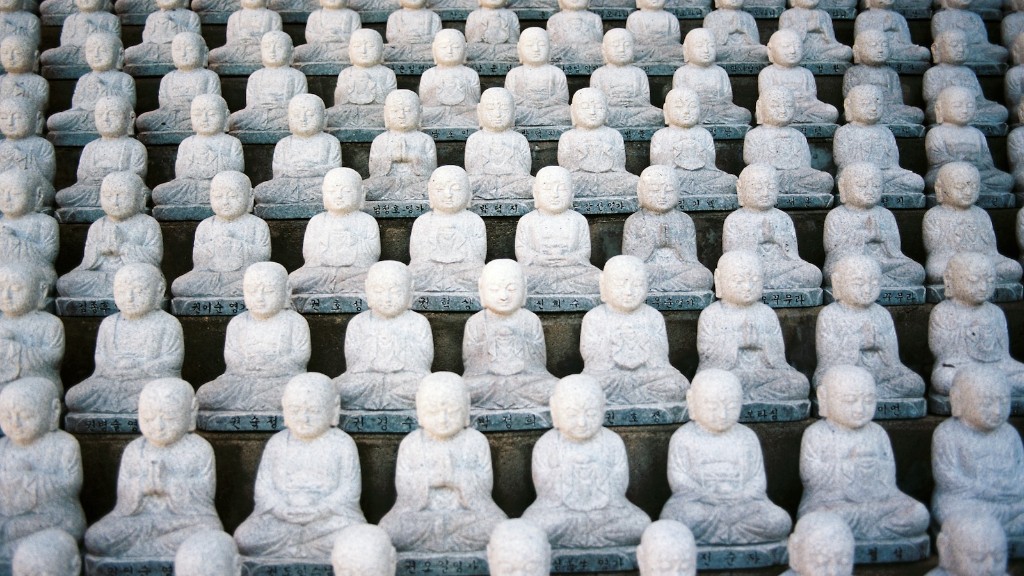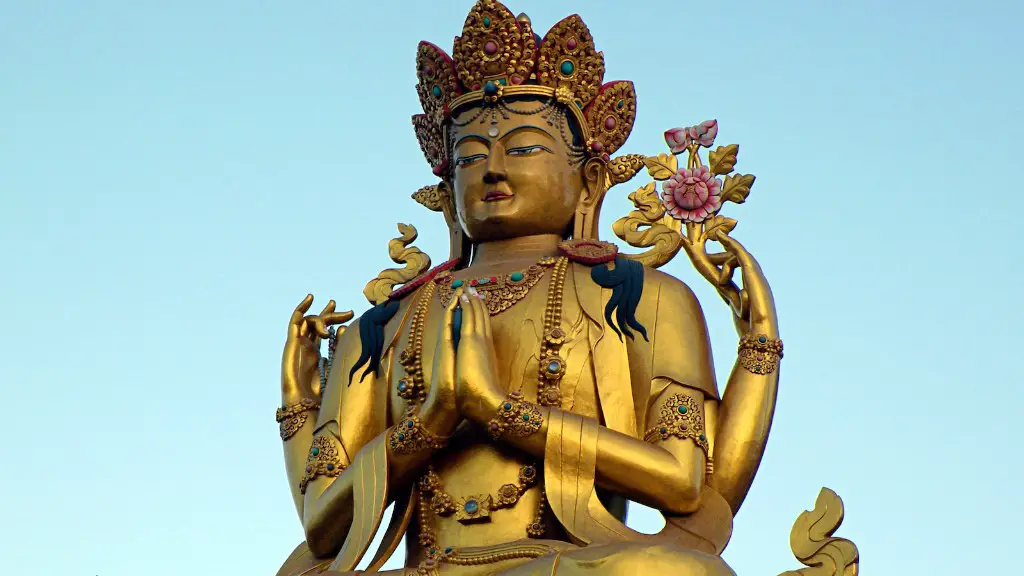Nirvana is an elusive concept in Buddhism and has been variously interpreted by different tradtions. In general, nirvana refers to a state beyond suffering, a state of perfect peace and bliss. Nirvana is often described as the extinguishing of the three fires of greed, hatred, and delusion. Once these fires are extinguished, liberation from the cycle of rebirth is attained.
Nirvana is the highest state that a being can achieve, a state of perfect peace and happiness. It is a state beyond suffering and desire, and one where a being is free from the cycle of birth and death.
What does Nirvana in Buddhism means?
Nirvana is the state to which all Buddhists aspire. It is the cessation of desire and hence the end of suffering. Nirvana in Sanskrit means “the blowing out”. It is understood as the extinguishment of the flame of personal desire, the quenching of the fire of life.
Nirvana is the goal of the Buddhist path. It is used to refer to the extinction of desire, hatred, and ignorance and, ultimately, of suffering and rebirth. Literally, it means “blowing out” or “becoming extinguished,” as when a flame is blown out or a fire burns out. Nirvana is the ultimate goal of the Buddhist path, the end of the cycle of rebirth.
How do you reach nirvana in Buddhism
Nirvana is often thought of as a state of bliss or perfect peace. In reality, it is the end of the cycle of rebirth and suffering. To reach Nirvana, one must let go of all attachment to things in the world, including the ego.
The ego is the part of the self that is concerned with personal gain and success. It is the driving force behind the desire for things like power, money, and fame. The ego is what keeps us attached to the things of this world and prevents us from reaching Nirvana.
To end the cycle of rebirth and suffering, we must let go of our attachment to the ego. This can be difficult, as the ego is often very strong. However, it is possible to overcome the ego with practice and patience. Once we let go of the ego, we can see things as they truly are and find true peace.
Nirvana is a highly sought after state in Buddhism because it represents the highest level of peace and happiness that a person can achieve. Once a person reaches nirvana, all of their individual desires and suffering go away. This makes it a very appealing goal for many people.
How do you know you’ve reached nirvana?
The nirvana-in-life is the highest achievement a monk can attain. It means that they have completely released themselves from desire and suffering, but they still have a body and a life. The nirvana-after-death is the complete cessation of everything, including consciousness and rebirth. This is the ultimate goal of a monk.
Nirvana is a state of perfect peace and bliss. It is the highest goal of Buddhism, and the ultimate goal of human life. There are four stages of Nirvana, and they are Sotapanna, Sakadagami, Anagami, and Arahant. Nirvana is the most popular word in Buddhism, and it is also known as Enlightenment. According to the legend, Lord Buddha attained the level of Nirvana in Bodh Gaya while meditating under the Bodhi Tree.
What are the 8 steps to nirvana?
The Eightfold Path is a set of eight practices that are designed to help an individual achieve enlightenment. The eight practices are: right view, right resolve, right speech, right conduct, right livelihood, right effort, right mindfulness, and right samadhi. Each of these practices is designed to help the individual develop a deeper understanding of the truth and achieve a state of harmony and peace.
Nirvana is a state of enlightenment that can be achieved by following the Noble Eightfold Path. This path includes right understanding, right thought, right speech, right action, right livelihood, right effort, right mindfulness, and right concentration. By following this path, you can overcome ignorance and attachment to earthly things, and end suffering.
Can a woman reach Nirvana in Buddhism
Arhatship is the highest level of achievement in Buddhist practice, and the Pali Canon provides examples of both male and female Arhats who have attained nirvana.
Buddhism is a religion that holds that everything is connected and intertwined. This principle is called Karma. It is the belief that good deeds will be rewarded with good things happening to a person, and bad deeds will be punished with bad things happening to a person. This principle is also connected to the belief in rebirth. It is believed that a person’s soul will be reborn into another body after they die, and that this new body will be determined by the karma that the person has accumulated in their previous life. Buddhism also holds that nothing is permanent and that change is the only constant. This is seen as a positive because it means that suffering is not permanent and that happiness is possible.
What are three facts about nirvana?
Nirvana was one of the most iconic grunge bands of the early 1990s. Though they were only active for a short time, they left a lasting impact on music and culture. Here are seven facts you might not know about Nirvana.
1. Nirvana’s debut single “Love Buzz” was a cover song.
2. In the “Smells Like Teen Spirit” music video, the janitor is a reference to Kurt Cobain’s old job at his old high school.
3. Originally the music video for “Lithium” was meant to be a cartoon.
4. Nirvana’s song “In Bloom” was originally written as a satire of macho rock songs.
5. “Smells Like Teen Spirit” was not written as an anthem for teenage rebels. Cobain has said that the song was actually written as a satire of the Seattle music scene.
6. Kurt Cobain was a huge fan of the band the Melvins. In fact, the original drumming lineup for Nirvana was made up of members of the Melvins.
7. Nirvana’s final studio album, “In Utero”, was recorded in secret in order to avoid leaks.
Nirvana completely changed the course of popular music in the late 80s. They brought punk and alternative music to the mainstream and topped the charts with their unique sound. Hair Metal and Pop artists were no longer the only ones getting radio play and airtime. Nirvana showed the world that there was something else out there, and their influence is still felt today.
Why do Buddhist celebrate nirvana
Nirvana Day, or Parinirvana Day, is observed annually on February 15th to remember when the Buddha attained complete nirvana. Nirvana is defined as the extinguishing of the three fires of greed, hate, and delusion, which leads to the end of the cycle of suffering and rebirth. On this day, Buddhists may meditate, chant, read religious texts, or perform other practices to honor the Buddha and his teachings.
There are many signs of spiritual enlightenment and awakening, but here are 10 of the most common examples:
1. Observing Your Patterns: You start to become more aware of the patterns in your life, both good and bad. This can be a sign that you are ready to start making changes to improve your life.
2. Feeling a Sense of Connection: You feel more connected to the world around you and to a higher power. This can be a sign that your spiritual awareness is increasing.
3. Letting Go of Attachment: You start to let go of attachments to things, people, and outcomes. This can be a sign that you are ready to start living in the present moment.
4. Finding Inner Peace: You find yourself more at peace with yourself and the world around you. This can be a sign that you are spiritually enlightened.
5. Increasing Your Intuition: You find yourself trusting your intuition more and more. This can be a sign that you are awakening your psychic abilities.
6. Having Synchronicity: You start to experience more synchronicity in your life. This can be a sign that you are attuning to the natural flow of the universe.
Do enlightened beings get angry?
Most enlightened people have a full emotional range. While self-transcendence does bring about positive emotions such as joy and peace, that’s not the full story. Many enlightened people still feel strong negative emotions, such as anger when they’re cut up in traffic.
While Buddhism is a tradition focused on spiritual liberation, it is not a theistic religion. The Buddha himself rejected the idea of a creator god, and Buddhist philosophers have even argued that belief in an eternal god is nothing but a distraction for humans seeking enlightenment.
Is nirvana a place or state of mind
Nirvana is a state of perfect peace and tranquility, of mind and body, and is the highest goal to be achieved in Hinduism, Buddhism, and Sikhism.It is a state beyond all suffering, beyond all craving and desire, and is the end of the cycle of birth and death. When one attains Nirvana, they are freed from the endless cycle of reincarnation and attain perfect bliss and peace.
Buddhists believe that life is a cycle of suffering and rebirth. However, if one reaches a state of enlightenment (nirvana), it is possible to escape this cycle forever. Siddhartha Gautama was the first person to reach this state of enlightenment and is known as the Buddha.
Final Words
Nirvana is an awakening to reality beyond the personal self. It is the end of suffering and the achievement of perfect peace. In Buddhism, it is the highest goal that a person can attain.
In Buddhism, nirvana is the highest state that a person can attain. It is a state of complete peace and freedom from suffering. In nirvana, a person is free from all desires and attachments. This state is said to be the end of the cycle of birth and death, and the person who attains it is said to be enlightened.



